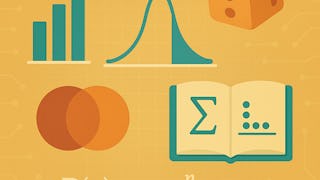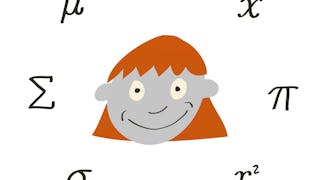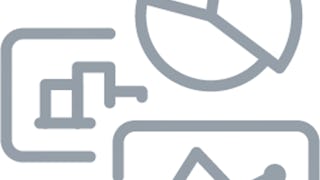This is the fourth of eight courses in the Google Advanced Data Analytics Certificate. In this course, you’ll discover how data professionals use statistics to analyze data and gain important insights. You'll explore key concepts such as descriptive and inferential statistics, probability, sampling, confidence intervals, and hypothesis testing. You'll also learn how to use Python for statistical analysis and practice communicating your findings like a data professional.


您将学到什么
Explore and summarize a dataset
Use probability distributions to model data
Conduct a hypothesis test to identify insights about data
Perform statistical analyses using Python
您将获得的技能
要了解的详细信息

添加到您的领英档案
27 项作业
了解顶级公司的员工如何掌握热门技能

积累 Probability and Statistics 领域的专业知识
- 向行业专家学习新概念
- 获得对主题或工具的基础理解
- 通过实践项目培养工作相关技能
- 通过 Google 获得可共享的职业证书

该课程共有6个模块
You’ll explore the role of statistics in data science and identify the difference between descriptive and inferential statistics. You’ll learn how descriptive statistics can help you quickly summarize a dataset and measure the center, spread, and relative position of data.
涵盖的内容
12个视频6篇阅读材料4个作业3个非评分实验室2个插件
You’ll learn the basic rules for calculating probability for single events. Next, you’ll discover how data professionals use methods such as Bayes’ theorem to describe more complex events. Finally, you’ll learn how probability distributions such as the binomial, Poisson, and normal distribution can help you better understand the structure of data.
涵盖的内容
14个视频7篇阅读材料6个作业3个非评分实验室4个插件
Data professionals use smaller samples of data to draw conclusions about large datasets. You’ll learn about the different methods they use to collect and analyze sample data and how they avoid sampling bias. You’ll also learn how sampling distributions can help you make accurate estimates.
涵盖的内容
11个视频7篇阅读材料4个作业3个非评分实验室2个插件
You’ll explore how data professionals use confidence intervals to describe the uncertainty of their estimates. You'll learn how to construct and interpret confidence intervals, and how to avoid some common misinterpretations.
涵盖的内容
7个视频3篇阅读材料4个作业3个非评分实验室
Hypothesis testing helps data professionals determine if the results of a test or experiment are statistically significant or due to chance. You’ll learn about the basic steps for any hypothesis test and how hypothesis testing can help you draw meaningful conclusions about data.
涵盖的内容
8个视频8篇阅读材料5个作业3个非评分实验室
In this end-of-course project, you’ll use statistical methods such as hypothesis testing to analyze a workplace scenario dataset.
涵盖的内容
5个视频10篇阅读材料4个作业6个非评分实验室
获得职业证书
将此证书添加到您的 LinkedIn 个人资料、简历或履历中。在社交媒体和绩效考核中分享。
位教师

提供方
从 Probability and Statistics 浏览更多内容
 状态:免费试用
状态:免费试用 状态:免费试用
状态:免费试用Birla Institute of Technology & Science, Pilani
 状态:免费试用
状态:免费试用University of Amsterdam
 状态:免费试用
状态:免费试用
人们为什么选择 Coursera 来帮助自己实现职业发展




学生评论
852 条评论
- 5 stars
87.31%
- 4 stars
10.12%
- 3 stars
1.51%
- 2 stars
0.58%
- 1 star
0.46%
显示 3/852 个
已于 Dec 16, 2023审阅
Even tough I am from the statistics' background but still I love the course as they define each and every detail explicitly.
已于 Sep 19, 2023审阅
Exceptional! I've learned so much about statistics with such a clarity, and how they are being practiced in real life. Thank you, instructor!
已于 Dec 13, 2024审阅
It was quite a technical course and got harder along the way. However the course content made catching up with the technical courses highlighted in this course easier.
常见问题
Organizations of all types and sizes have business processes that generate massive volumes of data. Every moment, all sorts of information gets created by computers, the internet, phones, texts, streaming video, photographs, sensors, and much more. In the global digital landscape, data is increasingly imprecise, chaotic, and unstructured. As the speed and variety of data increases exponentially, organizations are struggling to keep pace.
Data science and advanced data analytics are part of a field of study that uses raw data to create new ways of modeling and understanding the unknown. To gain insights, businesses rely on data professionals to acquire, organize, and interpret data, which helps inform internal projects and processes. Data scientists and advanced data analysts rely on a combination of critical skills, including statistics, scientific methods, data analysis, and artificial intelligence.
A data professional is a term used to describe any individual who works with data and/or has data skills. At a minimum, a data professional is capable of exploring, cleaning, selecting, analyzing, and visualizing data. They may also be comfortable with writing code and have some familiarity with the techniques used by statisticians and machine learning engineers, including building models, developing algorithmic thinking, and building machine learning models.
Data professionals are responsible for collecting, analyzing, and interpreting large amounts of data within a variety of different organizations. The role of a data professional is defined differently across companies. Generally speaking, data professionals possess technical and strategic capabilities that require more advanced analytical skills such as data manipulation, experimental design, predictive modeling, and machine learning. They perform a variety of tasks related to gathering, structuring, interpreting, monitoring, and reporting data in accessible formats, enabling stakeholders to understand and use data effectively. Ultimately, the work of data professionals helps organizations make informed, ethical decisions.
Large volumes of data — and the technology needed to manage and analyze it — are becoming increasingly accessible. Because of this, there has been a surge in career opportunities for people who can tell stories using data, such as senior data analysts and data scientists. These professionals collect, analyze, and interpret large amounts of data within a variety of different organizations. Their responsibilities require advanced analytical skills such as data manipulation, experimental design, predictive modeling, and machine learning.
更多问题
提供助学金,



